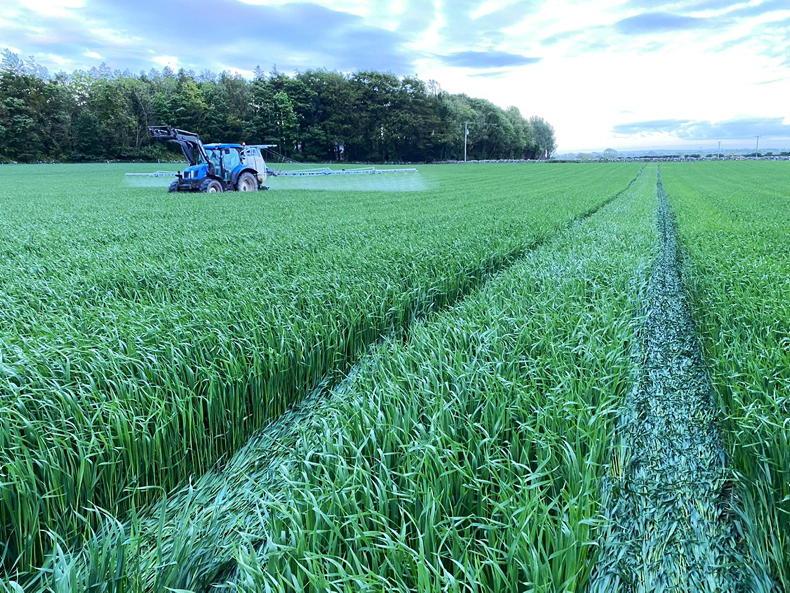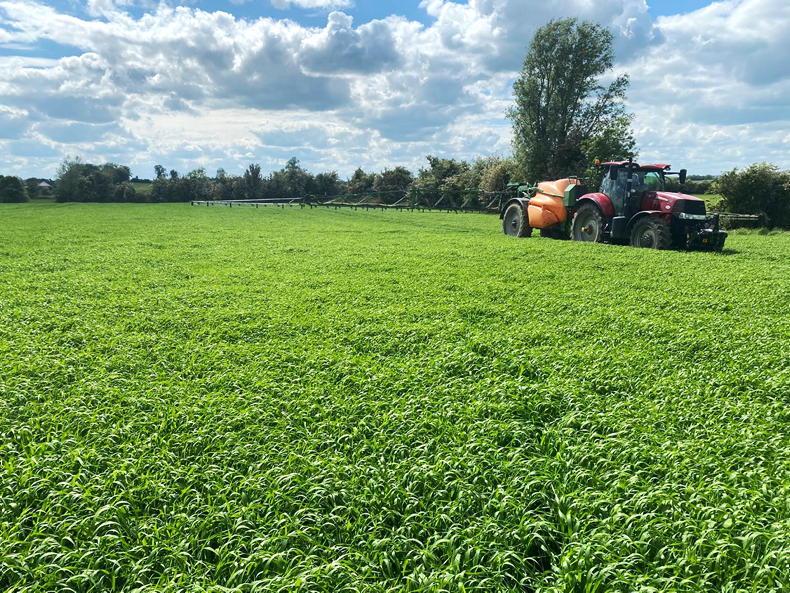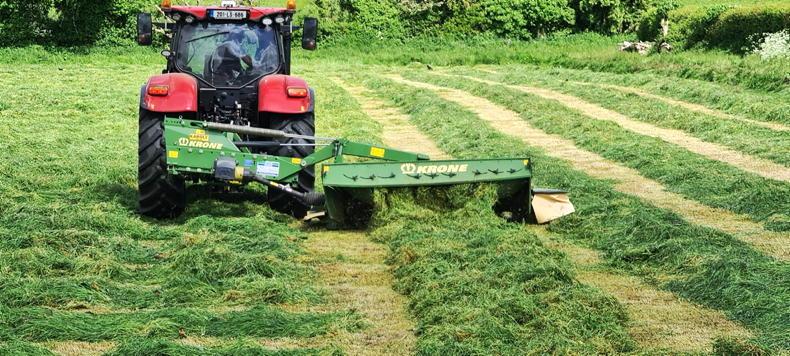Michael Kennedy –
Athenry,
Co Galway
There hasn’t been much rain in Galway over the past two weeks, explains Michael. However, conditions up until then had been very broken. During the month of May, over 100mm of rain fell on his farm. The kinder weather has been beneficial for crops and Michael hopes to make his first cut of silage this week.

Michael applying a T1 fungicide onto his spring barley crops.
His earlier planted potatoes are now 20cm in height and are coming along well. Blight pressure is building however, and he expects to apply the crop’s first fungicide this week.
Blight pressure in the west is generally similar to most potato growing areas, so fungicide spray intervals will likely be seven to 10 days.
He only finished planting the last field of potatoes at the end of May, due to poor weather and a high workload. Potato grading and bagging is ongoing and so far, consumer demand has remained relatively good.
He questions how a harvest without the use of the desiccant active diquat will work, especially for growers in the west and northwest
Michael also grows certified Queens and Record seed potatoes.
He thinks there could be opportunities to increase his seed area in the future. All crops have now received their pre-emergence herbicide spray of Most Micro and Shotput.
He questions how a harvest without the use of the desiccant active diquat will work, especially for growers in the west and northwest. In his case, flailing leaves crops very exposed to crow damage.
He is happy with the progress of all of his cereal crops. His winter barley received a T2 of Mettle (1.2l/ha) and Arizona (1.2l/ha) at the end of May. The countdown is now on to harvest.
Michael’s spring oat crops received a PGR spray consisting of Ceraide (0.96l/ha) and Optimus (0.25l/ha) at the end of May. The crop also received a fungicide spray of Mettle (1/ha) and Talius (0.25l/ha), as well as Wolftrax manganese (300g/ha).
His spring barley crops have also received a T1 of Mettle (1l/ha) as well as Avena Nova (0.14l/ha). Both his spring barley and oats received an aphicide earlier in May.
Brendan Lynch – Ardee,
Co Louth
Conditions have been good for getting field work done in Co Louth. There has been little rain over the last week and ground trafficability is excellent. He finished grading the last of his 2020 potatoes last week and stores are now empty. Most of the field work this week consists of spraying.

Brendan has been busy applying fungicdes onto his cereal crops.
Since talking to Brendan last, he applied a pre-emerge herbicide on all of his potato crops, Defy (at 2.5l/ha) and Shotput (at 0.6l/ha). Many of his potato crops have now emerged. With humidity levels expected to be high this week, his blight control programme will soon kick off. Once he starts, he will apply a blight spray every seven days. Brendan sprays with an Amazon UX4200 sprayer with 28m booms and full section control.
His spring barley crops are looking thick and last week received a T1 of Decoy (0.4l/ha) and Comet (0.5l/ha), as well as Axial Pro (0.65l/ha) and Medax Max (0.3l/ha).
He is happy with his winter wheat crops, as canopies are thick and green. He applied a T2 fungicide spray last week of Arizona (1l/ha), Aquino (1.4l/ha) and Turret (0.9l/ha), as well as Precision Mag trace elements (2l/ha).
His winter oat crops were knocked back in the spring due to the harsh weather, but Brendan feels they are slowly making a recovery
Brendan thinks his winter barley crops have reasonable potential, but sunshine is vital over the coming weeks. They received a head spray three weeks ago of Helix (0.8l/ha), Imtrex (1l/ha) and Mag S (2.8l/ha).
His winter oat crops were knocked back in the spring due to the harsh weather, but Brendan feels they are slowly making a recovery. They received their head spray this week of Helix (1l/ha), Tazar (0.52l/ha), as well as Mag S (2l/ha).
The petals have now shed on his winter oilseed rape and the crop has received Amistar (0.8l/ha). Brendan also applied (25l/ha) of N16 liquid fertiliser.
He intends on chopping his oilseed rape and oat straw this year, as well as some backward winter wheat crops under the Straw Incorporation Measure. He normally chops an amount of straw, but intends on increasing his area this year due to the scheme.
Seamus Duggan –
Durrow,
Co Laois
When talking to Seamus this week, he was in the middle of making hay. There has been little rainfall in Laois over the past two weeks and ground conditions are excellent. After a slow start, his fodder beet crops are developing fast.
“I’ve never seen a growth rate in beet like this before,” Seamus said.

Seamus mowing grass for hay this week.
He applied the crop’s first weed spray last week, along with an aphicide. He said that he couldn’t get into the field any earlier as the ground had turned extremely soft due to weeks of rain. He will wait and see what the weed pressure is like throughout the season, but this year could potentially see a two-spray herbicide programme.
Winter barley
Since talking to Seamus last, he has applied a head spray of Decoy (0.4l/ha) and Priaxor (0.8l/ha) onto his winter malting barley crops. His Craft variety had been looking poor all season, but has responded well to the heat and moisture. It is now on par with his Electrum variety.
It’s been a low disease pressure year for winter barley due to the cold, harsh spring. Pressure remains low on most crops, but the heat and humidity this week may change that.
There is some rhynchosporium present in his later sown spring barley crops
Spring barley crop canopies are dense, says Seamus. His early sown Tungson malting crops received a T0 fungicide spray of Proline and have since received a T1 of Decoy and Comet. They are nearly due a head spray, as the awns are just emerging.
There is some rhynchosporium present in his later sown spring barley crops, however. They recently received a T1 of Helix (0.65l/ha) and Modum (0.45l/ha), as well as Moddus (0.15l/ha). Seamus has since decided to apply Terpal onto these spring barley crops. Growth has been rapid and the crops are very soft, he says.
Some of his later sown spring barley crops have been severely damaged. In some cases, up to 50% of the plants are dead. He questions if this is frost related, as he knows of three other growers in the area whose crops are also affected.

Michael Kennedy –
Athenry,
Co Galway
There hasn’t been much rain in Galway over the past two weeks, explains Michael. However, conditions up until then had been very broken. During the month of May, over 100mm of rain fell on his farm. The kinder weather has been beneficial for crops and Michael hopes to make his first cut of silage this week.

Michael applying a T1 fungicide onto his spring barley crops.
His earlier planted potatoes are now 20cm in height and are coming along well. Blight pressure is building however, and he expects to apply the crop’s first fungicide this week.
Blight pressure in the west is generally similar to most potato growing areas, so fungicide spray intervals will likely be seven to 10 days.
He only finished planting the last field of potatoes at the end of May, due to poor weather and a high workload. Potato grading and bagging is ongoing and so far, consumer demand has remained relatively good.
He questions how a harvest without the use of the desiccant active diquat will work, especially for growers in the west and northwest
Michael also grows certified Queens and Record seed potatoes.
He thinks there could be opportunities to increase his seed area in the future. All crops have now received their pre-emergence herbicide spray of Most Micro and Shotput.
He questions how a harvest without the use of the desiccant active diquat will work, especially for growers in the west and northwest. In his case, flailing leaves crops very exposed to crow damage.
He is happy with the progress of all of his cereal crops. His winter barley received a T2 of Mettle (1.2l/ha) and Arizona (1.2l/ha) at the end of May. The countdown is now on to harvest.
Michael’s spring oat crops received a PGR spray consisting of Ceraide (0.96l/ha) and Optimus (0.25l/ha) at the end of May. The crop also received a fungicide spray of Mettle (1/ha) and Talius (0.25l/ha), as well as Wolftrax manganese (300g/ha).
His spring barley crops have also received a T1 of Mettle (1l/ha) as well as Avena Nova (0.14l/ha). Both his spring barley and oats received an aphicide earlier in May.
Brendan Lynch – Ardee,
Co Louth
Conditions have been good for getting field work done in Co Louth. There has been little rain over the last week and ground trafficability is excellent. He finished grading the last of his 2020 potatoes last week and stores are now empty. Most of the field work this week consists of spraying.

Brendan has been busy applying fungicdes onto his cereal crops.
Since talking to Brendan last, he applied a pre-emerge herbicide on all of his potato crops, Defy (at 2.5l/ha) and Shotput (at 0.6l/ha). Many of his potato crops have now emerged. With humidity levels expected to be high this week, his blight control programme will soon kick off. Once he starts, he will apply a blight spray every seven days. Brendan sprays with an Amazon UX4200 sprayer with 28m booms and full section control.
His spring barley crops are looking thick and last week received a T1 of Decoy (0.4l/ha) and Comet (0.5l/ha), as well as Axial Pro (0.65l/ha) and Medax Max (0.3l/ha).
He is happy with his winter wheat crops, as canopies are thick and green. He applied a T2 fungicide spray last week of Arizona (1l/ha), Aquino (1.4l/ha) and Turret (0.9l/ha), as well as Precision Mag trace elements (2l/ha).
His winter oat crops were knocked back in the spring due to the harsh weather, but Brendan feels they are slowly making a recovery
Brendan thinks his winter barley crops have reasonable potential, but sunshine is vital over the coming weeks. They received a head spray three weeks ago of Helix (0.8l/ha), Imtrex (1l/ha) and Mag S (2.8l/ha).
His winter oat crops were knocked back in the spring due to the harsh weather, but Brendan feels they are slowly making a recovery. They received their head spray this week of Helix (1l/ha), Tazar (0.52l/ha), as well as Mag S (2l/ha).
The petals have now shed on his winter oilseed rape and the crop has received Amistar (0.8l/ha). Brendan also applied (25l/ha) of N16 liquid fertiliser.
He intends on chopping his oilseed rape and oat straw this year, as well as some backward winter wheat crops under the Straw Incorporation Measure. He normally chops an amount of straw, but intends on increasing his area this year due to the scheme.
Seamus Duggan –
Durrow,
Co Laois
When talking to Seamus this week, he was in the middle of making hay. There has been little rainfall in Laois over the past two weeks and ground conditions are excellent. After a slow start, his fodder beet crops are developing fast.
“I’ve never seen a growth rate in beet like this before,” Seamus said.

Seamus mowing grass for hay this week.
He applied the crop’s first weed spray last week, along with an aphicide. He said that he couldn’t get into the field any earlier as the ground had turned extremely soft due to weeks of rain. He will wait and see what the weed pressure is like throughout the season, but this year could potentially see a two-spray herbicide programme.
Winter barley
Since talking to Seamus last, he has applied a head spray of Decoy (0.4l/ha) and Priaxor (0.8l/ha) onto his winter malting barley crops. His Craft variety had been looking poor all season, but has responded well to the heat and moisture. It is now on par with his Electrum variety.
It’s been a low disease pressure year for winter barley due to the cold, harsh spring. Pressure remains low on most crops, but the heat and humidity this week may change that.
There is some rhynchosporium present in his later sown spring barley crops
Spring barley crop canopies are dense, says Seamus. His early sown Tungson malting crops received a T0 fungicide spray of Proline and have since received a T1 of Decoy and Comet. They are nearly due a head spray, as the awns are just emerging.
There is some rhynchosporium present in his later sown spring barley crops, however. They recently received a T1 of Helix (0.65l/ha) and Modum (0.45l/ha), as well as Moddus (0.15l/ha). Seamus has since decided to apply Terpal onto these spring barley crops. Growth has been rapid and the crops are very soft, he says.
Some of his later sown spring barley crops have been severely damaged. In some cases, up to 50% of the plants are dead. He questions if this is frost related, as he knows of three other growers in the area whose crops are also affected.











 This is a subscriber-only article
This is a subscriber-only article











SHARING OPTIONS: